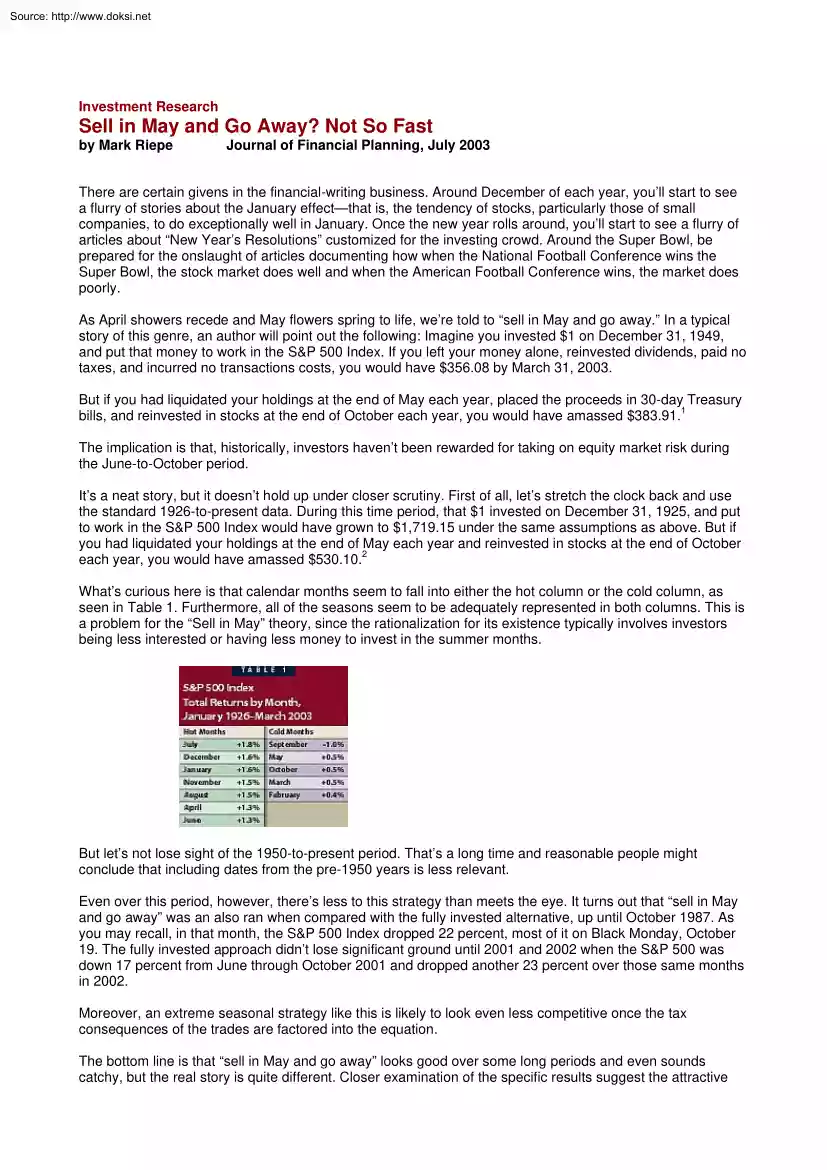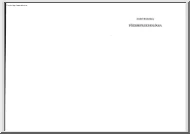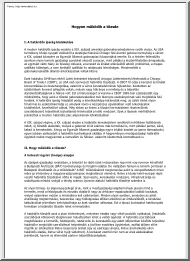Datasheet
Year, pagecount:2003, 2 page(s)
Language:English
Downloads:2
Uploaded:July 30, 2020
Size:483 KB
Institution:
-
Comments:
Journal of Financial Planning
Attachment:-
Download in PDF:Please log in!
Comments
No comments yet. You can be the first!Most popular documents in this category
Content extract
Source: http://www.doksinet Investment Research Sell in May and Go Away? Not So Fast by Mark Riepe Journal of Financial Planning, July 2003 There are certain givens in the financial-writing business. Around December of each year, you’ll start to see a flurry of stories about the January effectthat is, the tendency of stocks, particularly those of small companies, to do exceptionally well in January. Once the new year rolls around, you’ll start to see a flurry of articles about “New Year’s Resolutions” customized for the investing crowd. Around the Super Bowl, be prepared for the onslaught of articles documenting how when the National Football Conference wins the Super Bowl, the stock market does well and when the American Football Conference wins, the market does poorly. As April showers recede and May flowers spring to life, we’re told to “sell in May and go away.” In a typical story of this genre, an author will point out the following: Imagine you invested $1 on
December 31, 1949, and put that money to work in the S&P 500 Index. If you left your money alone, reinvested dividends, paid no taxes, and incurred no transactions costs, you would have $356.08 by March 31, 2003 But if you had liquidated your holdings at the end of May each year, placed the proceeds in 30-day Treasury bills, and reinvested in stocks at the end of October each year, you would have amassed $383.911 The implication is that, historically, investors haven’t been rewarded for taking on equity market risk during the June-to-October period. It’s a neat story, but it doesn’t hold up under closer scrutiny. First of all, let’s stretch the clock back and use the standard 1926-to-present data. During this time period, that $1 invested on December 31, 1925, and put to work in the S&P 500 Index would have grown to $1,719.15 under the same assumptions as above But if you had liquidated your holdings at the end of May each year and reinvested in stocks at the end of
October each year, you would have amassed $530.102 What’s curious here is that calendar months seem to fall into either the hot column or the cold column, as seen in Table 1. Furthermore, all of the seasons seem to be adequately represented in both columns This is a problem for the “Sell in May” theory, since the rationalization for its existence typically involves investors being less interested or having less money to invest in the summer months. But let’s not lose sight of the 1950-to-present period. That’s a long time and reasonable people might conclude that including dates from the pre-1950 years is less relevant. Even over this period, however, there’s less to this strategy than meets the eye. It turns out that “sell in May and go away” was an also ran when compared with the fully invested alternative, up until October 1987. As you may recall, in that month, the S&P 500 Index dropped 22 percent, most of it on Black Monday, October 19. The fully invested
approach didn’t lose significant ground until 2001 and 2002 when the S&P 500 was down 17 percent from June through October 2001 and dropped another 23 percent over those same months in 2002. Moreover, an extreme seasonal strategy like this is likely to look even less competitive once the tax consequences of the trades are factored into the equation. The bottom line is that “sell in May and go away” looks good over some long periods and even sounds catchy, but the real story is quite different. Closer examination of the specific results suggest the attractive Source: http://www.doksinet results are, in fact, driven by just a few poor summers. I’m sure readers of this Journal get it, but your clients could probably use some reminding that there are no shortcuts when it comes to sound investing. Beating the market takes more than just grasping at strategies that come with a snappy slogan. Lessons for Investors Our study of seasonal investing proves once again that time in
the market is much more important than timing the market. The lesson? A disciplined strategy of investing in the stock market probably offers a better chance of helping you meet your long-term goals than any seasonal, market-timing strategy ever could. Endnotes 1. Another variation of this story is to sell at the end of April and buy back in at the end of October. Under this assumption, the result is $33622 2. If selling at the end of April and buying back in at the end of October, the result is $515.85 Mark W. Riepe, CFA, is senior vice president of Schwab Center for Investment Research in San Francisco, California (Charles Schwab & Co. Inc, member SIPC/NYSE, 0001-11604)
December 31, 1949, and put that money to work in the S&P 500 Index. If you left your money alone, reinvested dividends, paid no taxes, and incurred no transactions costs, you would have $356.08 by March 31, 2003 But if you had liquidated your holdings at the end of May each year, placed the proceeds in 30-day Treasury bills, and reinvested in stocks at the end of October each year, you would have amassed $383.911 The implication is that, historically, investors haven’t been rewarded for taking on equity market risk during the June-to-October period. It’s a neat story, but it doesn’t hold up under closer scrutiny. First of all, let’s stretch the clock back and use the standard 1926-to-present data. During this time period, that $1 invested on December 31, 1925, and put to work in the S&P 500 Index would have grown to $1,719.15 under the same assumptions as above But if you had liquidated your holdings at the end of May each year and reinvested in stocks at the end of
October each year, you would have amassed $530.102 What’s curious here is that calendar months seem to fall into either the hot column or the cold column, as seen in Table 1. Furthermore, all of the seasons seem to be adequately represented in both columns This is a problem for the “Sell in May” theory, since the rationalization for its existence typically involves investors being less interested or having less money to invest in the summer months. But let’s not lose sight of the 1950-to-present period. That’s a long time and reasonable people might conclude that including dates from the pre-1950 years is less relevant. Even over this period, however, there’s less to this strategy than meets the eye. It turns out that “sell in May and go away” was an also ran when compared with the fully invested alternative, up until October 1987. As you may recall, in that month, the S&P 500 Index dropped 22 percent, most of it on Black Monday, October 19. The fully invested
approach didn’t lose significant ground until 2001 and 2002 when the S&P 500 was down 17 percent from June through October 2001 and dropped another 23 percent over those same months in 2002. Moreover, an extreme seasonal strategy like this is likely to look even less competitive once the tax consequences of the trades are factored into the equation. The bottom line is that “sell in May and go away” looks good over some long periods and even sounds catchy, but the real story is quite different. Closer examination of the specific results suggest the attractive Source: http://www.doksinet results are, in fact, driven by just a few poor summers. I’m sure readers of this Journal get it, but your clients could probably use some reminding that there are no shortcuts when it comes to sound investing. Beating the market takes more than just grasping at strategies that come with a snappy slogan. Lessons for Investors Our study of seasonal investing proves once again that time in
the market is much more important than timing the market. The lesson? A disciplined strategy of investing in the stock market probably offers a better chance of helping you meet your long-term goals than any seasonal, market-timing strategy ever could. Endnotes 1. Another variation of this story is to sell at the end of April and buy back in at the end of October. Under this assumption, the result is $33622 2. If selling at the end of April and buying back in at the end of October, the result is $515.85 Mark W. Riepe, CFA, is senior vice president of Schwab Center for Investment Research in San Francisco, California (Charles Schwab & Co. Inc, member SIPC/NYSE, 0001-11604)





